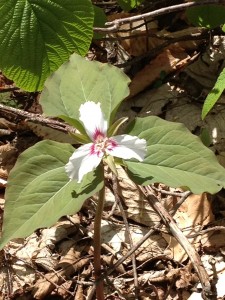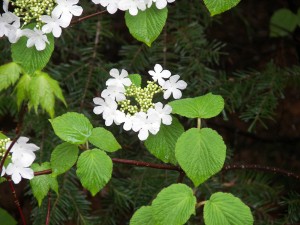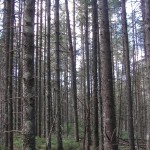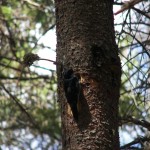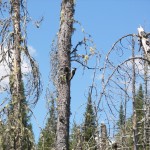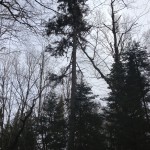Archive for May 2013
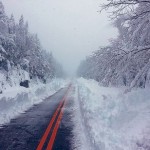
After 5 days away in northern Michigan, I arrived back home in the Adirondacks on Sunday evening of Memorial Day Weekend. I was half-listening to CNN news Monday morning, when I registered “Whiteface Mountain” and “3 FEET of snow”! I rewound the news hoping I incorrectly heard it. Five inches of rain had fallen in the lower elevations of the Adirondacks, and at higher elevations, it was snow – a great deal of snow in a short amount of time. Temperatures were in the 30s at lower elevations and as is usually the case, it was no doubt at least 10 degrees colder in the higher elevations.
I have had calls and email messages asking about Bicknell’s Thrush and how it could be faring. On May 19th I found many Bicknell’s Thrushes back, and many other species holding territories on Whiteface Mountain’s summit area. I immediately thought about the implications of such a severe weather event for all the species at high elevations. I thought about the female Bicknell’s Thrushes just returning, depleted from their long journey, arriving into a world of cold and snow. One person suggested that all the birds could simply move to lower elevations and wait out the snow melt. I highly doubt that these territorial species will leave their breeding grounds, and I suspect the event will end up taking a heavy toll on many of the birds. I recall a late April storm over a decade ago when we received a sudden two-foot snowfall. An American Woodcock ended up on someone’s porch in town (the only place it could find without snow). I called a rehabilitator friend and she immediately picked up the bird, but its weight was half of what it should have been. She tried to save the bird for 3 days, but it died. There is no doubt that many other birds died from that severe weather event. If only it was as simple as having all the birds temporarily move to a snowless place, but it just doesn’t work that way! I have observed thrushes, in particular American Robins and Hermit Thrushes, gather on plowed roadways when we’ve had late snow events. The Whiteface Mountain manager informed me that they were plowing the road and hoped to have it re-open right away. So I hope the snow-free roadway provides a place for Bicknell’s and Swainson’s Thrushes, American Robins (yes, there are actually nesting robins on Whiteface!), and other high elevation species to find food to get through this severe weather event. But only one mountain in the Adirondacks has a road, and all the other High Peaks are buried in deep snow. I have observed Bicknell’s Thrush appearing to fare well when we have received early October snowstorms before their fall migration – but not in THREE feet of snow!
A sarcastic comment was made on a recent group email message (not a birding group) about the heavy, late snowfall in the Adirondacks and how the person thought our problem was “global warming”. The ignorance in such statements is greatly troubling. While we can never prove that any one extreme weather event is the direct result of global warming, we can certainly look at the patterns and trends. Extreme weather events are becoming more frequent and more severe as we continue to add CO2 to the atmosphere at an unprecedented rate. The extreme weather graph mimics the Keeling Curve, and I might add, the world population curve also. (There were 3 billion people on the planet when I was born, and if I live to my life-expectancy, it will be 9 billion – a TRIPLING in one lifetime.) A warming planet will greatly increase the chances of extreme weather events. You would have to have your head in the sand not to notice this is already the case.
Each year, I become more worried climbing up the mountains and wondering what changes I will observe from the prior year. The rate of species expansion upslope is astounding. This year, Black-throated Green and Black-throated Blue Warblers are holding territories well over 4,000 feet on Whiteface Mountain – something that would not have been the case a decade ago. I tallied twice as many Swainson’s Thrushes during the Mountain Birdwatch survey of Whiteface Mountain in 2012 – again, something that would not have been the case a decade ago. (Scientists believe that the warming spring temperatures have allowed Swainson’s Thrushes to rapidly expand their breeding range upward in elevation – and become a potential competitor with Bicknell’s Thrush.) The steep decline in Bicknell’s Thrush numbers I’ve observed in the past couple years is particularly troubling. Observing such rapid ecological changes on the mountains over the course of a mere decade is like someone holding up a magnifying glass to climate change effects, and it is a frightening image.
Not a day goes by that I don’t think about my own unintended complicity in our warming planet, and the resulting harm done to other species, including extinction for some. In a talk that I give on climate change, I have a slide with photos depicting the typical U.S. lifestyle – two cars, 24-7 access to electricity, seemingly unlimited appliances to simplify our lives, a big (heated or cooled) home, air travel, and stores filled with a myriad of food choices, some shipped thousands of miles from around the world – all spewing CO2 into the atmosphere. I think you get the picture. We grew up with this lifestyle and no one wants to give it up. But our lifestyle is inflicting great harm on the life forms of our planet – including humans. Humans have changed the composition of the atmosphere enveloping Earth, which is a terrifying reality. As a result, the world in which our current life forms evolved is rapidly changing. Extreme weather events take a huge toll. For birds, it can hamper nesting (as 5 inches of rain and 3 feet of snow no doubt did this past weekend), and this year, bird migration was even more perilous as birds encountered extreme weather events (including changing wind patterns) when they were already depleted from such exhausting travel – resulting in a huge number of fatalities.
To leave this blog post on a more positive(!) note, I recently heard the tail-end of a piece on National Public Radio highlighting the work of a number of PhD students working on climate change. They are receiving millions of dollars for their research on artificially creating a photosynthesis process to take CO2 out of the atmosphere. It was the most hopeful news I’ve heard in a long time. There are many complications in their work, and their potential solution will take time, but it was so heartening to hear of young people concerned about climate change and working hard to find a solution. I hope they hurry.
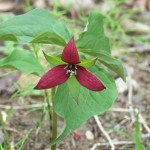
May, June, and July are wonderful months to look for wildflowers in the Adirondacks. For a wide diversity of wildflower species, look for trails in old growth deciduous forests. On an afternoon wildflower tour with a couple from Philadelphia, PA on May 14th this week, we found twenty wildflower species hiking a half-mile section of trail. Here is our list:
Hobblebush
Early Fly Honeysuckle
Two-leaved Toothwart
Painted Trillium
Purple Trillium
False Solomon’s Seal
Hairy Solomon’s Seal
Smooth Solomon’s Seal
Wild Sarsaparilla
Canada Mayflower
Starflower
Foamflower
Goldthread
Carolina Spring Beauty
Jack-in-the-pulpit
Trout Lily
Clintonia
Canada Violet
YellowViolet
Marsh Blue Violet
Bluets (at the home the couple rented)
We also visited a Black-backed Woodpecker nest site, where the male was still busy excavating the nest hole. He was inside the cavity and occasionally stuck his head out of the hole to shake away wood shavings! The female was foraging nearby.
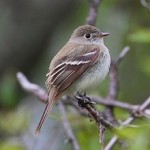
The Least Flycatcher has an unusual behavior among passerines. It forms “aggregations” or “clusters”. In the spring, males establish small territories among a dense cluster of Least Flycatchers, which is reminiscent of a lek mating system.
Least Flycatchers breed in deciduous, and mixed coniferous and deciduous, forests. The largest aggregations of Least Flycatchers that I have observed occur at forest openings. There is a large aggregation outside our house where there are several open acres surrounded by mixed forest, and on the way into Massawepie Mire where there is also a large, circular opening in the forest. Males give their loud “chebec” song all around the forest opening. They have a softer, almost “grumbled”, or also referred to as “guttural”, “speetz” call they give when changing perch locations.
Why do Least Flycatchers form aggregations when most other passerines do not nest in such social groups and establish their own, larger territories? There are several theories, some of which include: female preference for clustered males and pursuit of extra-pair matings, clustering may reduce nest predation, and one that I find intriguing, the open areas near forest aggregations may be neutral feeding grounds used by all the members of the cluster, which reduces conflict and allows for decreased territory sizes.
Least Flycatchers are often described as “pugnacious” and aggressive toward other species. They continuously attack other species when their territories overlap. This aggressive behavior in a cluster of birds may certainly support the theory of reduced nest predation among birds in aggregations.
Further study is needed to fully explain why Least Flycatchers nest in social clusters.
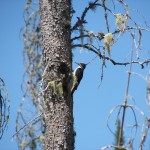
May is a fascinating month to be birding in the Adirondacks! The excavators are busy hollowing out tree space to raise young. In the past week, I have found two Black-backed Woodpecker nest sites, a Red-breasted Nuthatch nest, a Black-capped Chickadee nest, two likely Boreal Chickadee nest locations, and countless Yellow-bellied Sapsucker nests! The Jeopardy category would be titled “species that excavate nest holes”. Early to mid May is the best time to hear the sounds of the excavating activity.
Black-backed Woodpecker males do all the work of excavating a nest cavity. A male will change locations with the female long enough for her to inspect the nest hole before the male continues his non-stop work. Once the work takes him entirely inside the cavity, he occasionally sticks his head out to shake away the wood shavings.
The diversity of Black-backed Woodpecker nest site locations is remarkable. Last year, a pair nested 55 to 60 above the ground in a live Red Spruce tree on a hill. Two other nest hole locations observed that year were about 15 to 20 feet up in dead snags. These two other locations shared a commonality of a wet area filled with dead trees. Another birder observed a Black-backed Woodpecker nest hole in a telephone pole! This year, the first nest found is in a location with mature spruce trees on a hill. The nest is in a tall dead tree among live spruces. The hole is about 25 to 30 feet off the ground. The second nest found is in a wet area of dead snags. The nest hole is about 15 feet off the ground.
Late yesterday afternoon, on May 9, 2013, I ventured out at 4 p.m. to check the area where I had found the nest in a live Red Spruce last year. I immediately heard a Black-backed Woodpecker calling, and found a foraging female. I spent the next 3 hours sitting on the forest floor observing a pair that intermittently foraged and mated three times! They were continuously calling to each other as they foraged and then, as their vocal activity increased, I knew I would see mating again. The Black-backed Woodpeckers increase the frequency of their short calls and then start giving the longer rattle calls as the male flies in to mate with the female on a branch (usually close to the trunk). The male has a very distinctive flight as he approaches the female to mate – a slower, more fluttering, stiff flight pattern. After mating, the male flies away and the female remains on the branch for a short time before going back to foraging. Male Black-backed Woodpeckers actively mate with females during the course of excavating a nest hole. As I was noting the date, it suddenly occurred to me that it was the same date that I observed mating at this location last year – and it was likely the same pair! I have yet to find their new nest location.
On May 7, 2013, I heard a Boreal Chickadee calling at me, so I bushwhacked to the source of the sound. As I always do, I sat down on the mossy ground and tried to be inconspicuous (as much as a human can be…). The Boreal Chickadee continued to vocalize and I wondered if I would discover a nest hole. After awhile, a second Boreal Chickadee arrived and immediately began to inspect the dead trees around me. It continued to make its way closer and closer to me. I remained like a statue. I could hear it behind me a few feet, when suddenly I felt it attempt to land on me! I could feel the swoosh of the wings fluttering over my head. As much as I tried to stay still, it made me flinch, and the bird flew in front of me into a bush about two feet from my face! I have always found Boreal Chickadees to be extremely curious birds, but having one almost land on me was a first!
- Nest hole 25 to 30 feet off ground in dead conifer among live spruces.
- Closer view of the excavating male.
- Nest hole 15 feet off the ground in a dead snag.
- Live Red Spruce where a Black-backed Woodpecker excavated a nest hole 55 to 60 feet off the ground.
